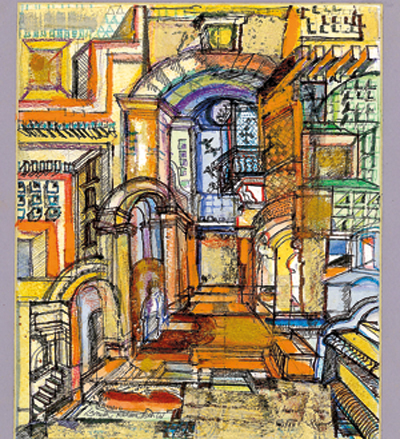The work of a truly multi-faceted man
 My immensely rewarding residency in Sri Lanka has been mainly influenced on a cultural level by three diverse icons. The first to be encountered was Lester James Peries. Indeed I may have never discovered the island if not for being chosen as the maestro’s personal assistant on The God King (1973). Vivid are the memories of sitting on Kassapa’s throne atop Sigiriya and discussing with LJP the latest European art movies.
My immensely rewarding residency in Sri Lanka has been mainly influenced on a cultural level by three diverse icons. The first to be encountered was Lester James Peries. Indeed I may have never discovered the island if not for being chosen as the maestro’s personal assistant on The God King (1973). Vivid are the memories of sitting on Kassapa’s throne atop Sigiriya and discussing with LJP the latest European art movies.
After scripting and producing a couple of foreign movies in the mid-’70s the written word overtook the dialogue of the moving image. Hence another icon was Sri Lanka’s pre-eminent librarian and bibliographer, H.A.I. (Ian) Goonetileke. His A Bibliography of Ceylon (2 vols. 1970), and the many discourses that occurred with him, led me circuitously to lexicography, primarily the words of Sri Lankan origin or association that have entered the Oxford English Dictionary.
Ismeth Raheem is the final, surviving, icon: a truly multi-faceted individual. An acclaimed architect (now retired), his non-professional interests and accomplishments are impressive. His art is perhaps foremost, ranging from extraordinary architectural paintings, rich in colour and enigmatic architectural elements, to his ornithological sketches, with a passionate bird-lover’s deft strokes. Where I am concerned, however, his main attribute is his role as collector and guardian – something I have aspired to – also his brilliance as a researcher. His knowledge and ability to access numerous cultural facets has proved of immense assistance in my historical and cultural writing.
To provide the country with an overview of his unique contribution to specialised art forms and savvy collection of artifacts, Raheem has assembled an exhibition. “Ismeth Raheem: Collected Works 1960-2019” runs from June 28 to July 1 at the Harold Peiris Gallery of the Lionel Wendt Art Centre and is, therefore, still able to be viewed. The exhibition includes drawings, paintings, batiks, engravings, etchings and sculptural panels in gold leaf, spanning almost 60 years of painstaking work. The majority are architectural in context. However, one-fifth concern natural history, both flora and fauna but predominantly the latter.
The scope of Raheem’s artistry has taken him to cultural centres globally. There are drawings created at museums in Copenhagen between 1966-1969, in Chennai in 1972, London from 1988-90, Jakarta in 2010, Singapore from 1990-2019 and, of course, Colombo during the 60-year period covered by the exhibition. Several works are topographical in nature, which though contemporary in context are embedded in tradition.
An exhibition bonus is a biographical note titled “Influences and Interests: My Life in Art”, in which he admits: “My work as an artist reflects diverse influences and interests. These include my professional work in architecture and interior design; my research and publications on colonial history, art history and the history of natural history; a life-long interest for both the natural and man-made worlds; and a taste for mythical, fantastical and surreal themes.”
Raheem’s first influence was Laki Senanyake, a fellow student at Royal College. Laki introduced Raheem to Ena de Silva and also to Geoffrey Bawa and Ulrik Plesner, a Danish architect who worked extensively in Sri Lanka. It is significant that at age 19, Raheem became an assistant at the architectural firm Edwards Reid & Begg, and in 1966, with Plesner’s support, gained a scholarship from the Danish government to complete an architectural degree at the Royal Danish Academy.
In addition, as Raheem states: “The exhibition features a series of paintings of Sri Lanka’s colonial era forts, and some abstract compositions that incorporate elements or perspectives from measured drawings or architectural plans. These reveal my absorption with the documentation of architectural history.”
Where Raheem’s artistic tendencies are concerned, one distinct influence was the Australian artist Donald Friend, encountered in 1972, whose technical approach – especially his drawings in the pen-and-ink medium – had considerable impact.
In 1978 Raheem established his own architectural practice with Pheroze Choksy, who had also trained at the Royal Danish Academy. Perhaps the most ambitious and ecological of their designs is the Cinnamon Lodge Hotel, Habarana. “Here, I was able to create a garden of more than 120 native dry zone tree species on 27 acres of degraded chena land. This involved the translocation of over 1,200 large trees from sites that were to be flooded under the Mahaweli Irrigation Project.”
To conclude, Raheem declares: “I spend many happy hours tracing images of museum exhibits in my sketchbook and later develop or absorb them into larger paintings. This exhibition also reflects my abiding interest in ornithology and includes a range of bird drawings, from life as well as from specimens preserved in the Colombo Museum.”


